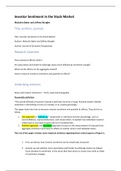Investor Sentiment in the Stock Market
Malcolm Baker and Jeffrey Wurgler
Title, authors, journals
Title: Investor Sentiment in the Stock Market
Authors: Malcolm Baker and Jeffrey Wurgler
Journal: Journal of Economic Perspectives
Research Question
How sentiment affects stocks?
Are speculative and harder-to-arbitrage stocks more affected by sentiment change?
What are the effects on the aggregate market?
How to measure investors sentiment and quantify its effects?
Underlying intuition
Noise and Investor Sentiment – Terms used interchangeably
Reasonable definition
“The overall attitude of investors toward a particular security or larger financial market. Market
sentiment is the feeling or tone of a market, or its crowd psychology.”
This paper looks into how to measure investor sentiment and quantify its effects. They do this as
follow:
1. One approach is “bottom up,” using biases in individual investor psychology, such as
overconfidence, representativeness, and conservatism, to explain how individual investors
underreact or overreact to past returns or fundamentals.
2. Another approach, the top-down approach focuses on the measurement of reduced-form,
aggregate sentiment and traces its effects to market returns and individual stocks.
The rest of the paper reviews some empirical evidence regarding three critical aspects of Figure 1.
1. First, we discuss how investor sentiment can be empirically measured.
2. Second, we ask whether more speculative and harder-to-arbitrage stocks are indeed
more sensitive to sentiment, in the sense that their prices co-move more with an index
of sentiment changes.
, 3. Third, we investigate whether current investor sentiment levels predict future returns as
sentiment wanes (perhaps spurred by fundamental news or an absence thereof) or as
arbitrage forces eventually accumulate to correct mispricing’s.
Main methodology
The key predictions of this framework come from its two moving parts. Consider first the possibility
that sentiment-based demand shocks vary across firms, while arbitrage is equally difficult across
firms.
❖ The key point is that in practice, the same securities that are difficult to value also tend to be
difficult to arbitrage.
Therefore, we are left with a very robust and testable conclusion:
The stocks most sensitive to investor sentiment will be those of companies that are younger,
smaller, more volatile, unprofitable, non–dividend paying, distressed, or with extreme
growth potential (or companies having analogous characteristics).
Conversely, “bond-like” stocks will be less driven by sentiment.
o Again, note that this assessment does not depend on specifying a fine definition of
investor sentiment or rely on just one arbitrage mechanism such as short-sales
constraints.
, Article Elaboration
Introduction
- The first assumption, laid out in Delong, Shleifer, Summers, and Waldmann (1990), is that
investors are subject to sentiment.
- Investor sentiment, defined broadly, is a belief about future cash flows and investment risks
that is not justified by the facts at hand.
- The second assumption, emphasized by Shleifer and Vishny (1997), is that betting against
sentimental investors is costly and risky.
- As a result, rational investors, or arbitrageurs as they are often called, are not as aggressive
in forcing prices to fundamentals as the standard model would suggest.
❖ Now, the question is no longer, as it was a few decades ago, whether investor
sentiment affects stock prices, but rather how to measure investor sentiment and
quantify its effects.
• One approach is “bottom up,” using biases in individual investor
psychology, such as overconfidence, representativeness, and
conservatism, to explain how individual investors underreact or
overreact to past returns or fundamentals.
• Another approach, the top-down approach focuses on the
measurement of reduced-form, aggregate sentiment and traces its
effects to market returns and individual stocks.
▪ The new directions in this top-down approach build
on the two broader and more irrefutable
assumptions of behavioral finance— sentiment and
limits to arbitrage—to explain which stocks are likely
to be most affected by sentiment, rather than simply
pointing out that the level of stock prices in the
aggregate depends on sentiment
❖ The investor sentiment approach that we develop in this paper is, by contrast,
distinctly “top down” and macroeconomic.
❖ Real investors and markets are too complicated to be neatly summarized by a few
selected biases and trading frictions.





